clock FIAT DUCATO 2007 Owner handbook (in English)
[x] Cancel search | Manufacturer: FIAT, Model Year: 2007, Model line: DUCATO, Model: FIAT DUCATO 2007Pages: 282, PDF Size: 4.49 MB
Page 87 of 282
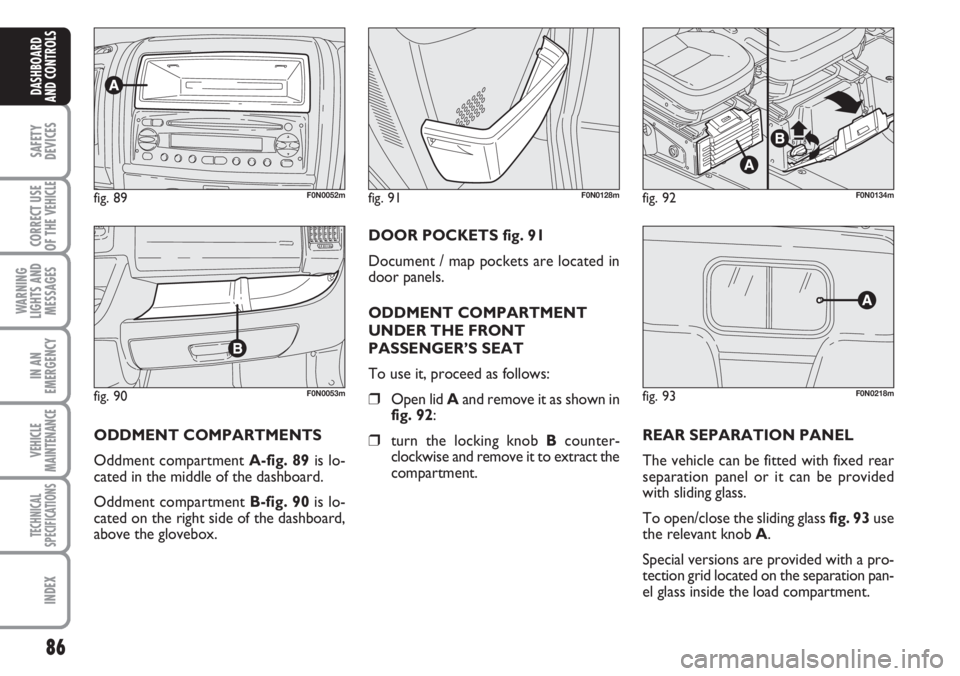
86
SAFETY
DEVICES
CORRECT USE
OF THE
VEHICLE
WARNING
LIGHTS AND
MESSAGES
IN AN
EMERGENCY
VEHICLE
MAINTENANCE
TECHNICAL
SPECIFICATIONS
INDEX
DASHBOARD
AND CONTROLS
fig. 90F0N0053m
fig. 89F0N0052mfig. 92F0N0134mfig. 91F0N0128m
ODDMENT COMPARTMENTS
Oddment compartment A-fig. 89is lo-
cated in the middle of the dashboard.
Oddment compartment B-fig. 90is lo-
cated on the right side of the dashboard,
above the glovebox.DOOR POCKETS fig. 91
Document / map pockets are located in
door panels.
ODDMENT COMPARTMENT
UNDER THE FRONT
PASSENGER’S SEAT
To use it, proceed as follows:
❒Open lid Aand remove it as shown in
fig. 92:
❒turn the locking knob Bcounter-
clockwise and remove it to extract the
compartment.REAR SEPARATION PANEL
The vehicle can be fitted with fixed rear
separation panel or it can be provided
with sliding glass.
To open/close the sliding glass fig. 93use
the relevant knob A.
Special versions are provided with a pro-
tection grid located on the separation pan-
el glass inside the load compartment.
fig. 93F0N0218m
Page 93 of 282
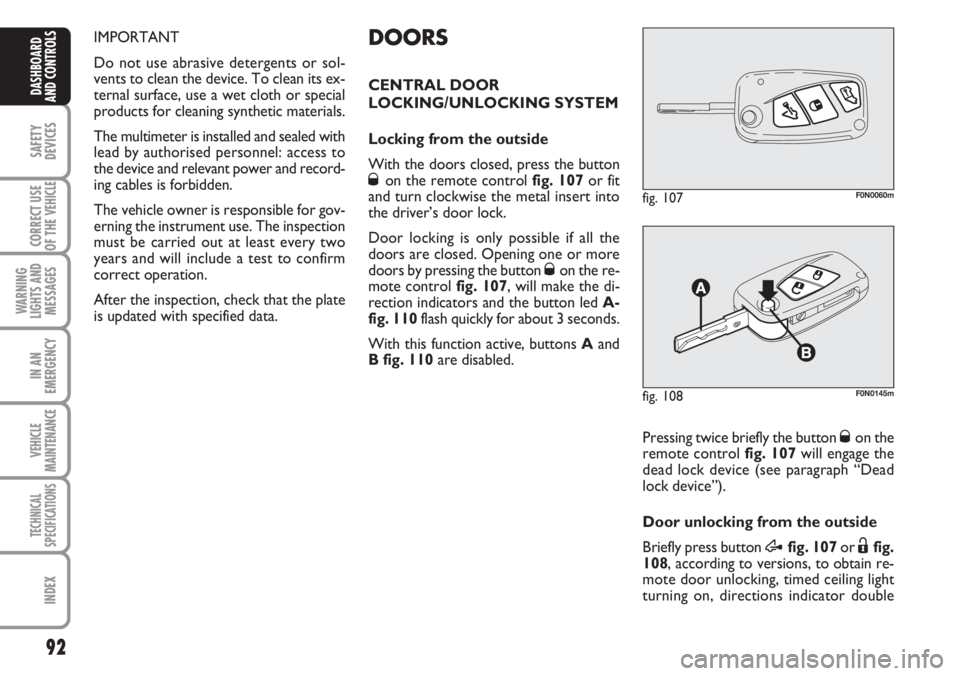
92
SAFETY
DEVICES
CORRECT USE
OF THE
VEHICLE
WARNING
LIGHTS AND
MESSAGES
IN AN
EMERGENCY
VEHICLE
MAINTENANCE
TECHNICAL
SPECIFICATIONS
INDEX
DASHBOARD
AND CONTROLS
IMPORTANT
Do not use abrasive detergents or sol-
vents to clean the device. To clean its ex-
ternal surface, use a wet cloth or special
products for cleaning synthetic materials.
The multimeter is installed and sealed with
lead by authorised personnel: access to
the device and relevant power and record-
ing cables is forbidden.
The vehicle owner is responsible for gov-
erning the instrument use. The inspection
must be carried out at least every two
years and will include a test to confirm
correct operation.
After the inspection, check that the plate
is updated with specified data.DOORS
CENTRAL DOOR
LOCKING/UNLOCKING SYSTEM
Locking from the outside
With the doors closed, press the button
Øon the remote control fig. 107or fit
and turn clockwise the metal insert into
the driver’s door lock.
Door locking is only possible if all the
doors are closed. Opening one or more
doors by pressing the button
Øon the re-
mote control fig. 107, will make the di-
rection indicators and the button led A-
fig. 110flash quickly for about 3 seconds.
With this function active, buttons Aand
B fig. 110are disabled.
fig. 107F0N0060m
Pressing twice briefly the button Øon the
remote control fig. 107will engage the
dead lock device (see paragraph “Dead
lock device”).
Door unlocking from the outside
Briefly press button
Æfig. 107or Ëfig.
108, according to versions, to obtain re-
mote door unlocking, timed ceiling light
turning on, directions indicator double
fig. 108F0N0145m
Page 94 of 282
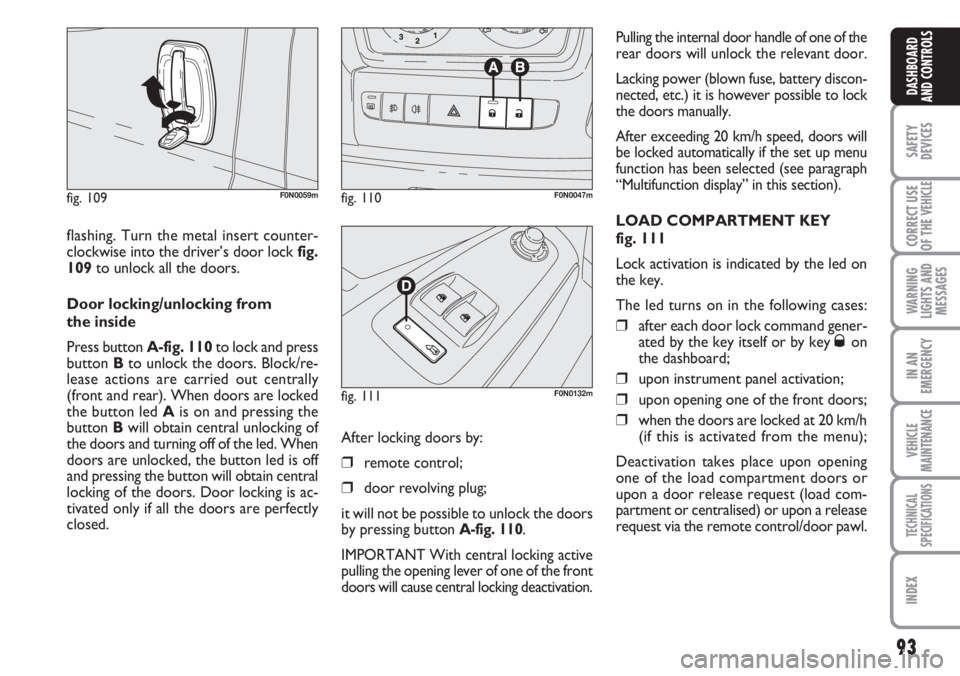
93
SAFETY
DEVICES
CORRECT USE
OF THE
VEHICLE
WARNING
LIGHTS AND
MESSAGES
IN AN
EMERGENCY
VEHICLE
MAINTENANCE
TECHNICAL
SPECIFICATIONS
INDEX
DASHBOARD
AND CONTROLS
flashing. Turn the metal insert counter-
clockwise into the driver’s door lock fig.
109to unlock all the doors.
Door locking/unlocking from
the inside
Press button A-fig. 110to lock and press
button Bto unlock the doors. Block/re-
lease actions are carried out centrally
(front and rear). When doors are locked
the button led Ais on and pressing the
button Bwill obtain central unlocking of
the doors and turning off of the led. When
doors are unlocked, the button led is off
and pressing the button will obtain central
locking of the doors. Door locking is ac-
tivated only if all the doors are perfectly
closed.
fig. 109F0N0059mfig. 110F0N0047m
fig. 111F0N0132m
Pulling the internal door handle of one of the
rear doors will unlock the relevant door.
Lacking power (blown fuse, battery discon-
nected, etc.) it is however possible to lock
the doors manually.
After exceeding 20 km/h speed, doors will
be locked automatically if the set up menu
function has been selected (see paragraph
“Multifunction display” in this section).
LOAD COMPARTMENT KEY
fig. 111
Lock activation is indicated by the led on
the key.
The led turns on in the following cases:
❒after each door lock command gener-
ated by the key itself or by key Øon
the dashboard;
❒upon instrument panel activation;
❒upon opening one of the front doors;
❒when the doors are locked at 20 km/h
(if this is activated from the menu);
Deactivation takes place upon opening
one of the load compartment doors or
upon a door release request (load com-
partment or centralised) or upon a release
request via the remote control/door pawl. After locking doors by:
❒remote control;
❒door revolving plug;
it will not be possible to unlock the doors
by pressing button
A-fig. 110.
IMPORTANT With central locking active
pulling the opening lever of one of the front
doors will cause central locking deactivation.
Page 97 of 282

96
SAFETY
DEVICES
CORRECT USE
OF THE
VEHICLE
WARNING
LIGHTS AND
MESSAGES
IN AN
EMERGENCY
VEHICLE
MAINTENANCE
TECHNICAL
SPECIFICATIONS
INDEX
DASHBOARD
AND CONTROLS
fig. 114F0N0129mfig. 115F0N0130mfig. 116F0N0131m
REAR DOUBLE DOOR
Opening the first door by hand
from the outside
Turn the key counterclockwise fig. 109
or press the remote control button ∞
and operate the handleA-fig. 114in the
direction of the arrow.
Closing the first door by hand from
the outside
Turn the key clockwise or press the but-
ton Áof the key with remote control.
Close first the left door and then the right
one. Opening the second door by hand
fig. 116
Pull the handle Cin the direction of the
arrow.
The double rear doors are fitted with a
catch which stops the opening at an an-
gle of approximately 90°.
Powered closing from the inside
fig. 117
Close both rear doors (first the left one
and then the right one) and press button
Dlocated on window control panel.
fig. 117F0N0132m
Page 162 of 282
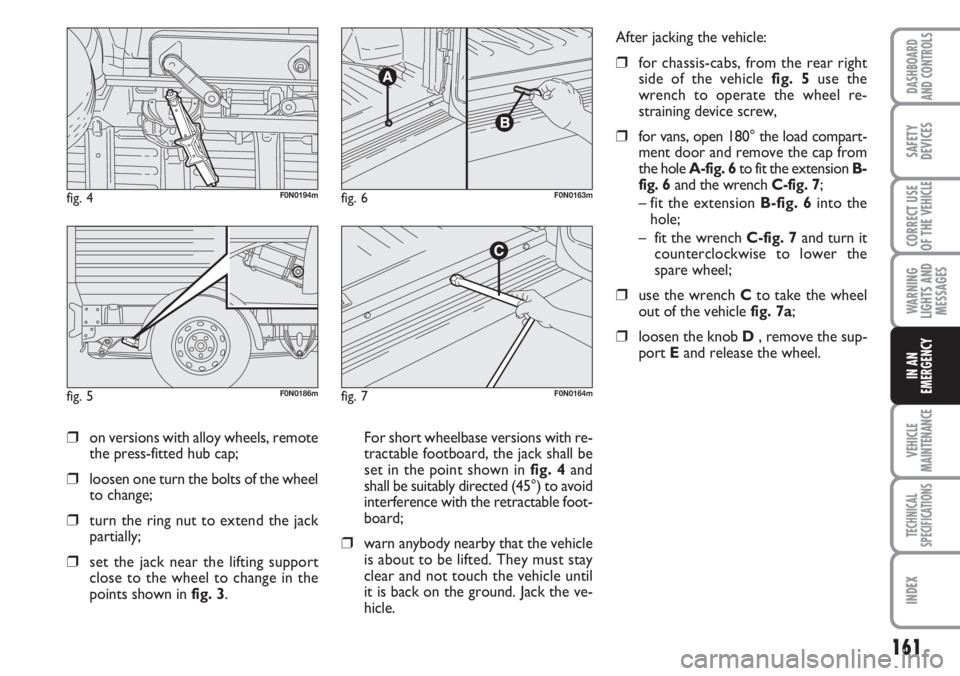
161
WARNING
LIGHTS AND
MESSAGES
VEHICLE
MAINTENANCE
TECHNICAL
SPECIFICATIONS
INDEX
DASHBOARD
AND CONTROLS
SAFETY
DEVICES
CORRECT USE
OF THE
VEHICLE
IN AN
EMERGENCY
❒on versions with alloy wheels, remote
the press-fitted hub cap;
❒loosen one turn the bolts of the wheel
to change;
❒turn the ring nut to extend the jack
partially;
❒set the jack near the lifting support
close to the wheel to change in the
points shown in fig. 3. For short wheelbase versions with re-
tractable footboard, the jack shall be
set in the point shown in fig. 4and
shall be suitably directed (45°) to avoid
interference with the retractable foot-
board;
❒warn anybody nearby that the vehicle
is about to be lifted. They must stay
clear and not touch the vehicle until
it is back on the ground. Jack the ve-
hicle.
fig. 4F0N0194m
fig. 5F0N0186m
fig. 6F0N0163m
fig. 7F0N0164m
After jacking the vehicle:
❒for chassis-cabs, from the rear right
side of the vehicle fig. 5use the
wrench to operate the wheel re-
straining device screw,
❒for vans, open 180° the load compart-
ment door and remove the cap from
the hole A-fig. 6to fit the extension B-
fig. 6and the wrench C-fig. 7;
– fit the extension B-fig. 6into the
hole;
– fit the wrench C-fig. 7and turn it
counterclockwise to lower the
spare wheel;
❒use the wrench Cto take the wheel
out of the vehicle fig. 7a;
❒loosen the knob D , remove the sup-
port Eand release the wheel.
Page 163 of 282
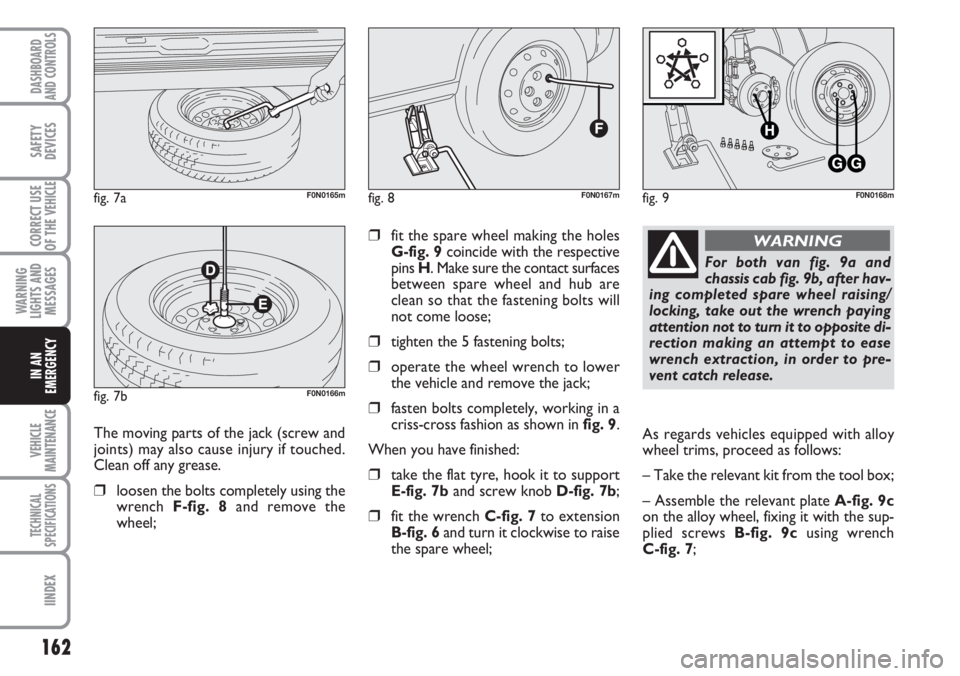
162
WARNING
LIGHTS AND
MESSAGES
VEHICLE
MAINTENANCE
TECHNICAL
SPECIFICATIONS
IINDEX
DASHBOARD
AND CONTROLS
SAFETY
DEVICES
CORRECT USE
OF THE
VEHICLE
IN AN
EMERGENCY
❒fit the spare wheel making the holes
G-fig. 9coincide with the respective
pins H. Make sure the contact surfaces
between spare wheel and hub are
clean so that the fastening bolts will
not come loose;
❒tighten the 5 fastening bolts;
❒operate the wheel wrench to lower
the vehicle and remove the jack;
❒fasten bolts completely, working in a
criss-cross fashion as shown in fig. 9.
When you have finished:
❒take the flat tyre, hook it to support
E-fig. 7band screw knob D-fig. 7b;
❒fit the wrench C-fig. 7to extension
B-fig. 6and turn it clockwise to raise
the spare wheel;
fig. 8F0N0167mfig. 9F0N0168m
The moving parts of the jack (screw and
joints) may also cause injury if touched.
Clean off any grease.
❒loosen the bolts completely using the
wrench F-fig. 8and remove the
wheel;
fig. 7aF0N0165m
fig. 7bF0N0166m
For both van fig. 9a and
chassis cab fig. 9b, after hav-
ing completed spare wheel raising/
locking, take out the wrench paying
attention not to turn it to opposite di-
rection making an attempt to ease
wrench extraction, in order to pre-
vent catch release.
WARNING
As regards vehicles equipped with alloy
wheel trims, proceed as follows:
– Take the relevant kit from the tool box;
– Assemble the relevant plate A-fig. 9c
on the alloy wheel, fixing it with the sup-
plied screws B-fig. 9cusing wrench
C-fig. 7;
Page 164 of 282
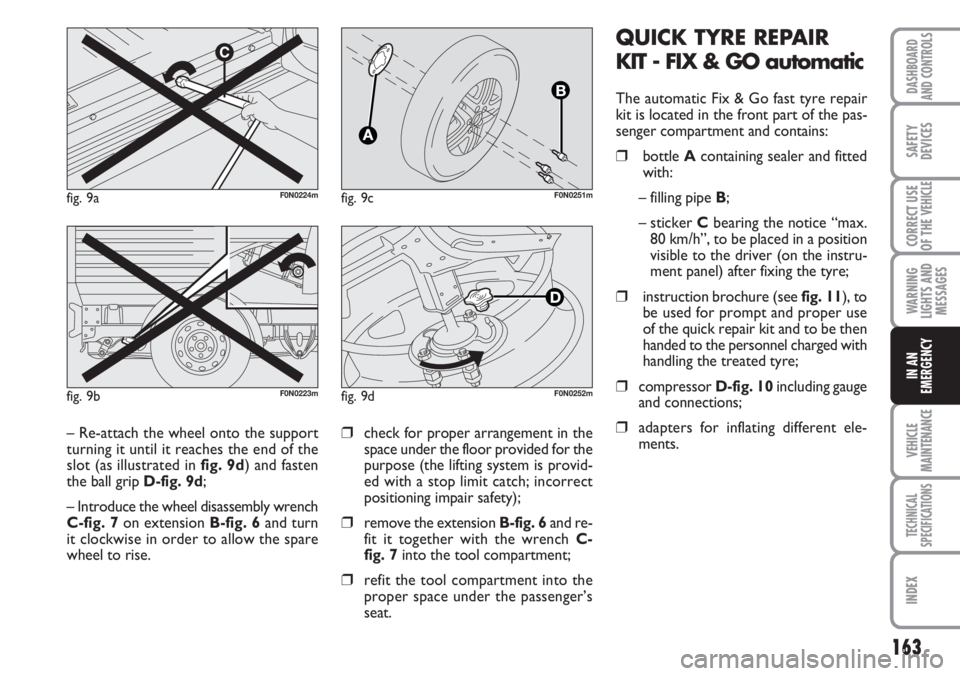
163
WARNING
LIGHTS AND
MESSAGES
VEHICLE
MAINTENANCE
TECHNICAL
SPECIFICATIONS
INDEX
DASHBOARD
AND CONTROLS
SAFETY
DEVICES
CORRECT USE
OF THE
VEHICLE
IN AN
EMERGENCY
QUICK TYRE REPAIR
KIT - FIX & GO automatic
The automatic Fix & Go fast tyre repair
kit is located in the front part of the pas-
senger compartment and contains:
❒bottle A containing sealer and fitted
with:
– filling pipe B;
– sticker Cbearing the notice “max.
80 km/h”, to be placed in a position
visible to the driver (on the instru-
ment panel) after fixing the tyre;
❒instruction brochure (see fig. 11), to
be used for prompt and proper use
of the quick repair kit and to be then
handed to the personnel charged with
handling the treated tyre;
❒compressor D-fig. 10including gauge
and connections;
❒adapters for inflating different ele-
ments.❒check for proper arrangement in the
space under the floor provided for the
purpose (the lifting system is provid-
ed with a stop limit catch; incorrect
positioning impair safety);
❒remove the extension B-fig. 6and re-
fit it together with the wrench C-
fig. 7into the tool compartment;
❒refit the tool compartment into the
proper space under the passenger’s
seat.
fig. 9aF0N0224m
fig. 9bF0N0223m
– Re-attach the wheel onto the support
turning it until it reaches the end of the
slot (as illustrated in fig. 9d) and fasten
the ball grip D-fig. 9d;
– Introduce the wheel disassembly wrench
C-fig. 7on extension B-fig. 6and turn
it clockwise in order to allow the spare
wheel to rise.
fig. 9cF0N0251m
fig. 9dF0N0252m
Page 168 of 282
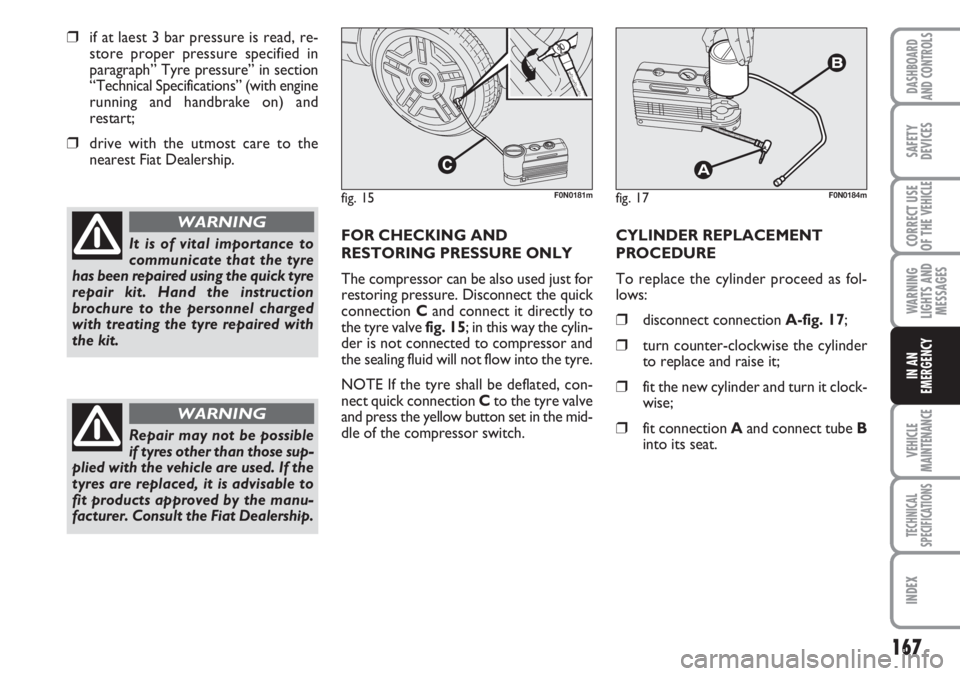
167
WARNING
LIGHTS AND
MESSAGES
VEHICLE
MAINTENANCE
TECHNICAL
SPECIFICATIONS
INDEX
DASHBOARD
AND CONTROLS
SAFETY
DEVICES
CORRECT USE
OF THE
VEHICLE
IN AN
EMERGENCY
❒if at laest 3 bar pressure is read, re-
store proper pressure specified in
paragraph” Tyre pressure” in section
“Technical Specifications” (with engine
running and handbrake on) and
restart;
❒drive with the utmost care to the
nearest Fiat Dealership.
FOR CHECKING AND
RESTORING PRESSURE ONLY
The compressor can be also used just for
restoring pressure. Disconnect the quick
connection Cand connect it directly to
the tyre valve fig. 15; in this way the cylin-
der is not connected to compressor and
the sealing fluid will not flow into the tyre.
NOTE If the tyre shall be deflated, con-
nect quick connection Cto the tyre valve
and press the yellow button set in the mid-
dle of the compressor switch.CYLINDER REPLACEMENT
PROCEDURE
To replace the cylinder proceed as fol-
lows:
❒disconnect connection A-fig. 17;
❒turn counter-clockwise the cylinder
to replace and raise it;
❒fit the new cylinder and turn it clock-
wise;
❒fit connection Aand connect tube B
into its seat.
It is of vital importance to
communicate that the tyre
has been repaired using the quick tyre
repair kit. Hand the instruction
brochure to the personnel charged
with treating the tyre repaired with
the kit.
WARNING
fig. 17F0N0184mfig. 15F0N0181m
Repair may not be possible
if tyres other than those sup-
plied with the vehicle are used. If the
tyres are replaced, it is advisable to
fit products approved by the manu-
facturer. Consult the Fiat Dealership.
WARNING
Page 169 of 282
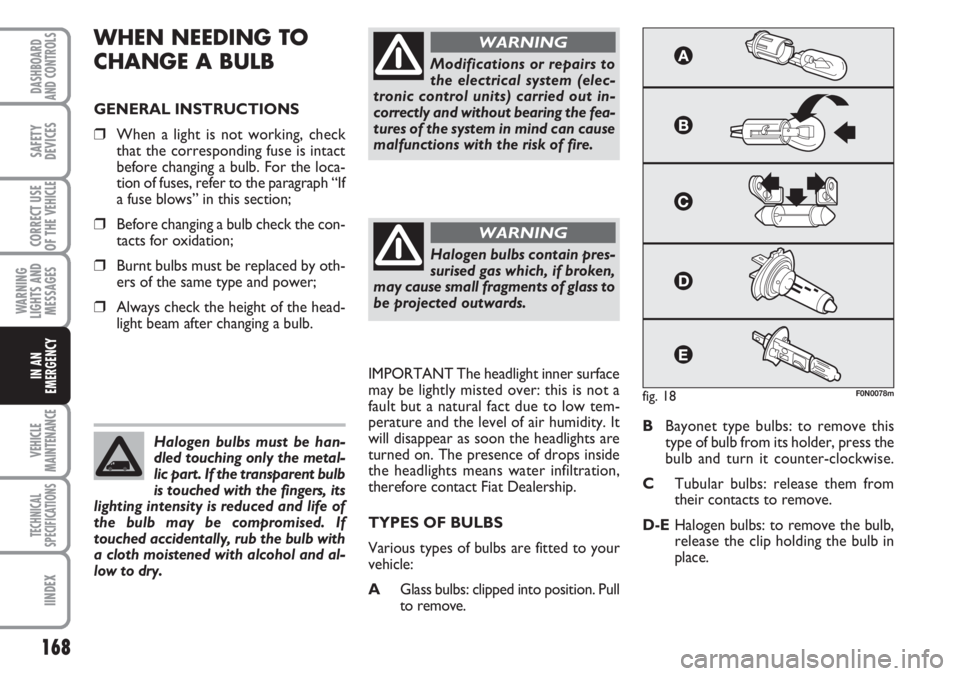
168
WARNING
LIGHTS AND
MESSAGES
VEHICLE
MAINTENANCE
TECHNICAL
SPECIFICATIONS
IINDEX
DASHBOARD
AND CONTROLS
SAFETY
DEVICES
CORRECT USE
OF THE
VEHICLE
IN AN
EMERGENCY
WHEN NEEDING TO
CHANGE A BULB
GENERAL INSTRUCTIONS
❒When a light is not working, check
that the corresponding fuse is intact
before changing a bulb. For the loca-
tion of fuses, refer to the paragraph “If
a fuse blows” in this section;
❒Before changing a bulb check the con-
tacts for oxidation;
❒Burnt bulbs must be replaced by oth-
ers of the same type and power;
❒Always check the height of the head-
light beam after changing a bulb.
IMPORTANT The headlight inner surface
may be lightly misted over: this is not a
fault but a natural fact due to low tem-
perature and the level of air humidity. It
will disappear as soon the headlights are
turned on. The presence of drops inside
the headlights means water infiltration,
therefore contact Fiat Dealership.
TYPES OF BULBS
Various types of bulbs are fitted to your
vehicle:
AGlass bulbs: clipped into position. Pull
to remove.BBayonet type bulbs: to remove this
type of bulb from its holder, press the
bulb and turn it counter-clockwise.
CTubular bulbs: release them from
their contacts to remove.
D-EHalogen bulbs: to remove the bulb,
release the clip holding the bulb in
place. Halogen bulbs must be han-
dled touching only the metal-
lic part. If the transparent bulb
is touched with the fingers, its
lighting intensity is reduced and life of
the bulb may be compromised. If
touched accidentally, rub the bulb with
a cloth moistened with alcohol and al-
low to dry.
Modifications or repairs to
the electrical system (elec-
tronic control units) carried out in-
correctly and without bearing the fea-
tures of the system in mind can cause
malfunctions with the risk of fire.
WARNING
Halogen bulbs contain pres-
surised gas which, if broken,
may cause small fragments of glass to
be projected outwards.
WARNING
fig. 18F0N0078m
Page 171 of 282
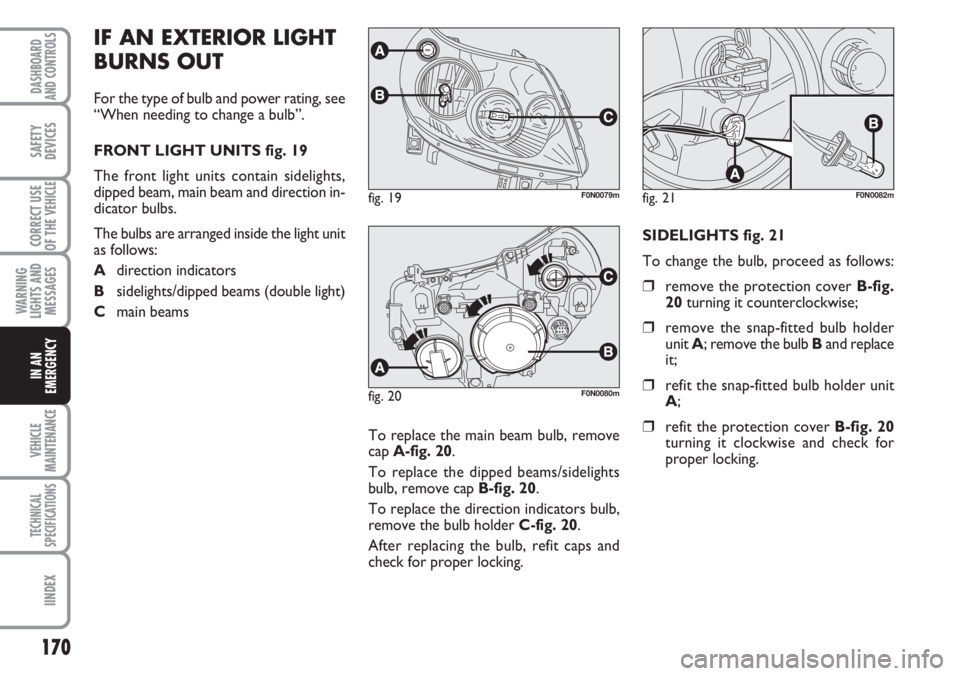
170
WARNING
LIGHTS AND
MESSAGES
VEHICLE
MAINTENANCE
TECHNICAL
SPECIFICATIONS
IINDEX
DASHBOARD
AND CONTROLS
SAFETY
DEVICES
CORRECT USE
OF THE
VEHICLE
IN AN
EMERGENCY
IF AN EXTERIOR LIGHT
BURNS OUT
For the type of bulb and power rating, see
“When needing to change a bulb”.
FRONT LIGHT UNITS fig. 19
The front light units contain sidelights,
dipped beam, main beam and direction in-
dicator bulbs.
The bulbs are arranged inside the light unit
as follows:
Adirection indicators
Bsidelights/dipped beams (double light)
Cmain beams
To replace the main beam bulb, remove
cap A-fig. 20.
To replace the dipped beams/sidelights
bulb, remove cap B-fig. 20.
To replace the direction indicators bulb,
remove the bulb holder C-fig. 20.
After replacing the bulb, refit caps and
check for proper locking.SIDELIGHTS fig. 21
To change the bulb, proceed as follows:
❒remove the protection cover B-fig.
20turning it counterclockwise;
❒remove the snap-fitted bulb holder
unit A; remove the bulb Band replace
it;
❒refit the snap-fitted bulb holder unit
A;
❒refit the protection cover B-fig. 20
turning it clockwise and check for
proper locking.
fig. 19F0N0079mfig. 21F0N0082m
fig. 20F0N0080m